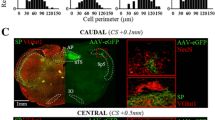Abstract
Reportedly, more than 90% of the testicular afferents of the dog are of the polymodal type. The possible involvement of these afferents in modulation of respiration was studied using anesthetized dogs, which had been vagotomized and with both common carotid arteries ligated. Electrical stimulation of the superior spermatic nerve at an intensity of 1/5 Tc (Tc: threshold intensity for C-fiber activation) induced no substantial changes in respiration, while above 1/2 Tc it induced an increase in minute expiratory volume (V E), or a decrease followed by an increase inV E. The pattern of respiratory change was converted from the former to the latter by increasing the stimulation frequency while maintaining the same intensity. Mechanical stimulation of the testis through a stimulator with a tip of 1 cm in diameter caused an increase ofV E at 200 g and a decrease followed by an increase ofV E above 500 g. Intraarterial injection of bradykinin (3×10−6 M), hypertonic saline (1.5 M) and high K+ solution (180 mM) to the spermatic artery induced similar respiratory changes. Pneumograms showed a shift in end-expiratory position even at stimulus intensities without significantV E changes. Phrenic nerve recordings from some artificially ventilated dogs, revealed an prolongation of the first expiratory phase followed by augmentation of phrenic activity, mostly an increase in respiratory rate. Comparison between afferent activities and reflex respiratory changes suggests that above described two types of respiratory changes are brought about by the activities of testicular polymodal receptors.
Similar content being viewed by others
References
Albano J-P, Garnier L (1983) Bulbo-spinal respiratory effects originating from the splanchnic afferents. Resp Physiol 51:229–239
Bessou P, Perl ER (1969) Response of cutaneous sensory units with unmyelinated fibers to noxious stimuli. J Neurophysiol 32:1025–1043
Blumberg H, Haupt P, Jänig W, Kohler W (1983) Encoding of visceral noxious stimuli in the discharge pattern of visceral afferent fibres from the colon. Pflügers Arch 398:33–40
Crowley RT (1941) Reflex modification of respiration by intestinal distention. Am J Physiol 133:p253–254
DeTroyer A, Kelly S, Macklem PT, Zin WA (1985) Mechanics of intercostal space and actions of external and internal intercostal muscles. J Clin Invest 75:850–857
Eldridge FL, Gill-Kumar P, Millhorn DE, Waldrop TG (1981) Spinal inhibition of phrenic motoneurones by stimulation of afferents from peripheral muscles. J Physiol 311:67–79
Garnier L, Albano JP (1975a) Donnees preliminaires sur l'origine des fibres afferentes du nerf splanchnique ayant un effet respiratoire. Comp Rend Seances Soc Biol 169:99–104
Garnier L, Albano JP (1975b) Modifications respiratoires consecutives a la stimulation electrique des afferences pancreatiques chez le chat legerement anesthesie. Comp Rend Seances Soc Biol 169:1001–1005
Haupt P, Jänig W, Kohler W (1983) Response pattern of visceral afferent fibres supplying the colon upon chemical and mechanical stimuli. Pflügers Arch 398:41–47
Kostreva DR, Hopp FA, Zuperku EJ, Igler FO, Coon RL, Kampine JP (1978) Respiratory inhibition with sympathetic afferent stimulation in the canine and primate. J Appl Physiol 44:718–724
Kumazawa T, Mizumura K (1977) Thin fibre receptors responding to mechanical, chemical, and thermal stimulation in the skeletal muscle of the dog. J Physiol 273:179–194
Kumazawa T, Mizumura K (1980a) Chemical responses of polymodal receptors of the scrotal contents in dogs. J Physiol 299:219–231
Kumazawa T, Mizumura K (1980b) Mechanical and thermal responses of polymodal receptors recorded from the superior spermatic nerve of dogs. J Physiol 299:233–245
Kumazawa T, Mizumura K, Sato J (1987) Response properties of polymodal receptors studied using in vitro testis superior spermatic nerve preparations of dogs. J Neurophysiol 57:702–711
Mizumura K, Sato J, Kumazawa T (1987) Effects of prostaglandins and other putative chemical intermediaries on the activity of canine testicular polymodal receptors studied in vitro. Pflügers Arch 408:565–572
Nishi K, Sakanashi M, Takenaka F (1977) Activation of afferent cardiac sympathetic nerve fibers of cats by pain producing substances and by noxious heat. Pflügers Arch 372:53–61
Prabhakar NR, Marek W, Loeschcke HH (1980) Varänderungen des Atemtypes während Stimulation des afferenten Sympathikus. Atemwegs Lungenkr 6:161–164
Prabhakar NR, Marek W, Loeschcke HH (1985) Altered breathing pattern elicited by stimulation of abdominal visceral afferents. J Appl Physiol 58:1755–1760
Reeve EB, Nanson EM, Rundle FF (1951) Observations on inhibitory respiratory reflexes during abdominal surgery. Clin Sci 10:65–87
Schaible H-G, Schmidt RF (1983) Activation of group III and IV sensory units in medial articular nerve by local mechanical stimulation of knee joint. J Neurophysiol 49:35–44
Schondorf R, Polosa C (1980) Effects of urinary bladder afferents on respiration. J Appl Physiol 48:826–832
Uchida Y, Murao S (1974) Bradykinin-induced excitation of afferent cardiac sympathetic nerve fibers. Jpn Heart J 15:84–91
Waldrop TG, Rybicki KJ, Kaufman MP, Ordway GA (1984) Activation of visceral thin-fiber afferents increases respiratory output in cats. Resp Physiol 58:187–196
Woolard HH, Carmichael EA (1933) The testis and referred pain. Brain 56:293–303
Author information
Authors and Affiliations
Rights and permissions
About this article
Cite this article
Mizumura, K., Tadaki, E. & Kumazawa, T. Respiratory changes induced by activation of testicular afferents in dogs. Pflugers Arch. 411, 27–33 (1988). https://doi.org/10.1007/BF00581642
Received:
Accepted:
Issue Date:
DOI: https://doi.org/10.1007/BF00581642




